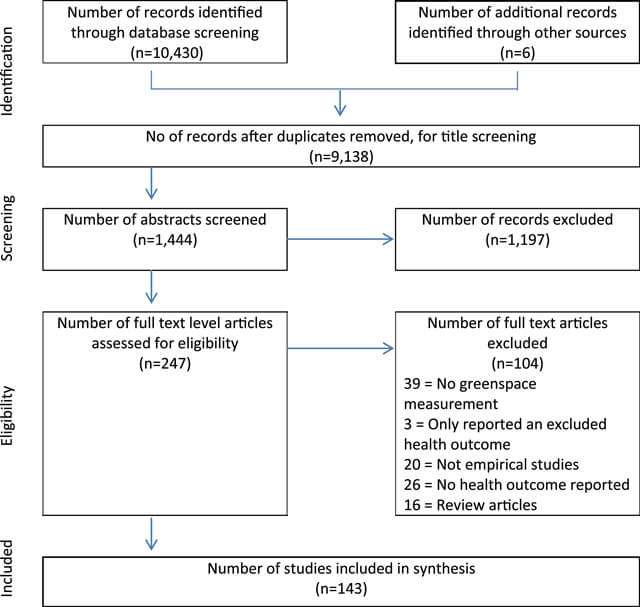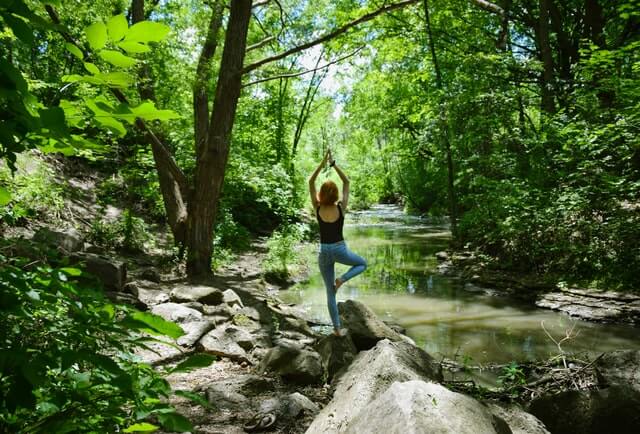Human diseases and disorders are a significant cause of mortality and morbidity worldwide. As a result, there has been an increased interest in the role greenspace can play in tackling the global burden of disease in recent years. Greenspace is an umbrella term encompassing parks, street greenery, green corridors, and even gardens.

There is growing evidence that greenspace exposure is associated with wide-ranging health benefits. For example, a recent meta-analysis found that greenspace exposure was associated with a substantial decrease in blood pressure, anxiety, and heart rate. There were also noteworthy decreases in diabetes and cardiovascular disease.
The evidence for the benefit of green space on mental health is also impressive. A systematic review found that natural environments positively impacted psychological outcomes for both healthy individuals and those with mental illness or cognitive impairment. In addition, the meta-analysis showed that there was an increase in self-esteem.
Here, we present a series of meta-analyses examining associations between self-reported green space exposure, biomarkers for several physiological processes (e.g., blood pressure, heart rate), and health outcomes, including cardiovascular mortality and diabetes incidence.
A new study at Norwich Medical School found even more reasons to spend time outdoors
The study, which was the largest of its kind, assessed 143 studies investigating the impact of green space exposure on health. Those studies included 290 million people from 20 countries across North America and Europe.

The scientists discovered that living in or visiting green spaces is associated with many health benefits, including better psychological well-being, reduced stress, and an improved sense of calmness and relaxation.
The study also found evidence to suggest that spending time in parks and green spaces can reduce blood pressure and cholesterol levels, improve sleep quality and increase cognitive development in children. In particular, they found that green space exposure is associated with wide-ranging health benefits, including reducing stress, anxiety, and depression in adults, reducing symptoms of ADHD and improving cognitive development in children. The review also identified the key characteristics of nature that contribute to these effects.
Further work is needed to address several gaps in the literature to build on this work, allow for more precise estimates for specific types of green spaces, and strengthen causal inferences.
What was found in the study?
The researchers found the beneficial effects of green space across all outcome categories. The effect size was most significant for physical activity, stress reduction, obesity, and diabetes. However, our findings also show some associations are more robust than others, with consistently larger effect sizes for mental health outcomes than physical health outcomes.
The results suggested that exposure to greenspace reduced the risk of diabetes, heart disease, stress, and high blood pressure levels. The effects of green space were more pronounced for younger participants (aged 0–18 years) than for older participants (aged 0–60 years). Furthermore, the study found that all nine health outcomes examined improved with increasing amounts of greenspace.
| Outcome | N (participants) | Effect MD (95% CI) | Heterogeneity I2 | P-value |
| Salivary cortisol | 7 (954) | −0.05 (−0.07, −0.04) | 0% | p < 0.001 |
| Heart rate | 10 (1058) | −2.57 (−4.30, −0.83) | 78% | p 0.004 |
| HDL cholesterol | 2 (3474) | −0.03 (−0.05, <−0.01) | 0% | p = 0.02 |
| Diastolic blood pressure | 12 (9695) | −1.97 (−3.45, −0.49) | 82% | p = 0.009 |
| Systolic blood pressure | 13 (9791) | −1.50 (−3.43, 0.44) | 78% | p = 0.13 |
| Change in HF power of HRV | 7 (826) | 91.87 (50.92, 132.82) | 49% | p < 0.001 |
| LF/(LF+HF) | 6 (266) | −0.06 (−0.08, −0.03) | 0% | p < 0.001 |
| HbA1c | 2 (174) | −0.77 (−1.86, 0.32) | 54% | p = 0.16 |
| Fasting blood glucose | 2 (3474) | −0.01 (−0.08, 0.07) | 0% | p = 0.84 |
| Total cholesterol | 2 (3474) | 0.03 (−0,05, 0.10) | 0% | p = 0.48 |
| LDL cholesterol | 2 (3474) | 0.04 (−0.03, 0.11) | 0% | p = 0.23 |
| Triglycerides | 2 (3474) | 0.06 (−0.01, 0.12) | 0% | p = 0.07 |
| Gestational age | 3 (22911) | < −0.01 (−0.05, 0.05) | 0% | p = 0.94 |

Dr. White said: “There’s now a wealth of evidence for a strong relationship between access to green space and health and well-being. Spending time outdoors in parks or green areas can help people improve their mental health. We’ve known for some time about the physical benefits of being in nature but what we’re beginning to understand is how this can also benefit our minds.”
Other known benefits of spending time outdoors
Spending time outdoors is good for the soul. Especially when you’re an avid gardener, it isn’t easy to be indoors for long periods. However, spending time outside in nature can improve your mood and attitude, lower stress levels, help you sleep better, and increase your overall level of happiness.

Since many people spend most of their day inside at work or school (and then spend even more time watching TV or on technology), it’s essential to take a break from the indoor world and get some sunshine and fresh air.
Spending time outdoors is good for your health. According to The New York Times, it can improve your immune system and help relieve asthma symptoms (according to The New York Times). Nature has also been known to improve blood pressure and heart rate, reducing the risk of heart disease. Being active in the outdoors can help you lose weight, too. It’s a great way to exercise without feeling like you’re exercising (and if you need some inspiration, check out our list of favorite gardening workouts).
Speaking of exercise, getting outside is a great way to get moving. You can garden all day long (without even realizing it!), and you won’t feel like you’re working out. Running around with your kids, walking the dog, or simply taking a stroll down the sidewalk counts as exercise.
Several studies have shown that spending time outside makes us happier. The sun’s rays are good for us. They help us produce vitamin D, which can help regulate our moods. Getting out has also been known to increase energy levels naturally. In addition, those who spend more time outside have reported better sleep than those who spend most of their time indoors. Another benefit of increased exposure to natural light during the daytime is that it helps us reset our biological clocks, so we’re ready for bed at night. And fresh air doesn’t hurt either!
How our busy daily routine in closed environments can impact our health
It’s been proven that a sedentary lifestyle can cause many problems related to circulation, anxiety, weight, and overall health. Therefore, it is essential to be aware of the signs and symptoms that may be your body’s way of signaling you to take a break.

Sedentary lifestyles are typical among people who work in offices. Once you reach your workstation, you will likely remain seated for most of the day. However, this can contribute to tension headaches and migraines, significantly decreasing productivity at work.
You are more likely to gain weight when you have a sedentary lifestyle because you do not burn as many calories. That is why it is essential to find ways to increase your daily activity levels. For example, taking regular breaks throughout the day will encourage you to move around more often.
Your mood can be affected by a sedentary lifestyle as it can result in low energy levels and less motivation. In addition, if you do not get enough exercise, it is also highly likely that you will experience low moods because no endorphins are released from physical activity.
It is essential to make sure that you manage your time effectively to avoid falling into a rut. This means setting aside time to get fresh air and exercise and time to spend with friends and family.
Why is nature beneficial for our mental health?
The connection between nature and the human mind is an ancient one. In ancient Greece, the physician Hippocrates said: “Walking is man’s best medicine.”
When we go for walks in a natural environment, we breathe fresh air filled with oxygen. This oxygen goes around our bodies and gets into our brains, which has a calming effect on our minds and improves our mood.
Sunlight also plays a role in improving our mood. This is because sunlight helps us produce vitamin D, which is essential for good physical and mental health. In addition, vitamin D regulates serotonin levels in the brain, which influences our mood and feelings of happiness.
This is not fully understood, but scientists have suggested that green spaces reduce stress by lowering the heart rate, decreasing muscle tension, and reducing negative emotions. Breathing fresh air can also boost energy. Green spaces can also help to improve mood, self-esteem, and motivation while contributing to feelings of social cohesion. In addition, exercise itself is known to cause chemical changes in the brain that may help combat depression, anxiety, and other mental health problems. The combination of training and being outdoors might therefore be particularly beneficial.
What’s the recommended minimum time for a person to spend time in nature?
The recommended minimum time to spend in nature is five minutes. This is the time required to start feeling the benefits of being outdoors. If you spend more time than this, the benefits will increase exponentially.
A study also showed that nature duration between 20 and 30 min, three times per week. This is likely because the memory and processing capacity of short-term working memory is limited, so a sufficient amount of time is required to make sense of input from the natural environment. Also, a 20-min walk in a green space could reduce blood pressure as much as walking for 40 minutes in an urban setting). This suggests that 20-min walks in nature are more beneficial than 40 min spent in urban environments.
A recent quantitative review found that exposure to nature for at least 120 min per week (20 min per day for six days) was associated with more excellent well-being outcomes than shorter exposures; however, there was no significant difference in well-being outcomes between 120 and 300 min per week (50 min per day).
Taking a walk through the woods can make you feel more optimistic than walking through other types of environments. Researchers have found that just looking at trees can help to boost your mental health. One study found that hospital patients with views of trees recovered faster and needed less medication than those without the same view.
Sports and activities that can be done while being in nature
When we hear the word “outdoors,” most of us think of sports we can play or activities, we can do in a wide-open space, such as hiking, running, swimming, cycling, camping, or touring. And these are all great ways to enjoy nature. But if you’re looking for some fresh ideas that can be done inside or outdoors, here are some suggestions:

Yoga. This exercise is excellent because it helps relieve stress and strain on your body by allowing you to focus on the present moment while practicing different postures and breathing techniques. It’s also a great way to stretch out your muscles after sitting at your desk after a long day.
Pilates. This type of exercise is similar to yoga in that it focuses on flexibility and balance. However, it can also help with back pain and other issues that arise from sitting for extended periods. Tai chi. This form of martial arts is based on slow movements with deep breathing techniques designed to strengthen both mind and body while increasing your energy levels. The practice has improved balance, mental clarity, and even lower blood pressure in people who have high blood pressure levels.









